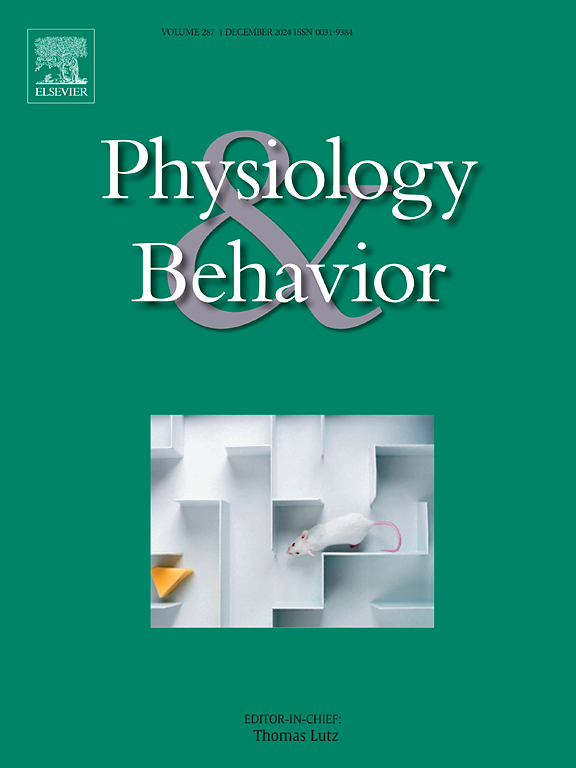The impact of partner interaction on brief social buffering in adolescent female rats as analyzed by deep learning-based object detection algorithms
IF 2.4
3区 医学
Q2 BEHAVIORAL SCIENCES
引用次数: 0
Abstract
Social buffering is a phenomenon whereby the stress response of anyone exposed to a distressing stimulus is alleviated by the presence of conspecific(s). In this study, we aimed to determine whether brief buffering (only 3 min) with conspecific immediately after fear conditioning can produce social buffering in adolescent Sprague-Dawley rats (4–5 weeks, male and female) and whether close partner interaction can impact brief social buffering in adolescent female rats. The rats received an electric shock in the black room of shuttle box, followed by a 3 min buffering period. After two learning sessions, the rats performed passive avoidance test individually, both immediately and 24 hr later. To reduce human bias and analyze variables not accessible to humans, data were analyzed using YOLOv8 and BoT-SORT, deep learning-based algorithm. As a result, Toy group, tested with an object resembling a rat, showed a significant increase in fear-related behavior for both sexes. Pair group, tested with a partner, showed a significant decrease in fear-related behavior in both sexes during the learning check, but only females maintained this decrease in the retention. In Pair female group, the longer the rat and its partner spent in the same room and the longer they stayed close, the higher the black room preference; this was a significant correlation. Therefore, we demonstrated that immediate brief social contact is sufficient to induce social buffering especially in female rats. In addition, social contact appears to be a key factor increasing the efficiency of social buffering.

基于深度学习的目标检测算法分析了伴侣互动对青春期雌性大鼠短暂社会缓冲的影响
社会缓冲是一种现象,即任何人暴露于令人痛苦的刺激时,其应激反应会因同种刺激物的存在而得到缓解。在本研究中,我们旨在确定青春期Sprague-Dawley大鼠(4-5周,雄性和雌性)的短暂缓冲(仅3分钟)是否能产生社会缓冲,以及亲密伴侣互动是否会影响青春期雌性大鼠的短暂社会缓冲。大鼠在穿梭箱黑房接受电击,缓冲时间为3分钟。两个学习阶段后,大鼠分别在第一时间和24小时后进行被动回避测试。为了减少人为偏见和分析人类无法访问的变量,使用YOLOv8和基于深度学习的BoT-SORT算法分析数据。结果,玩具组用一个类似老鼠的物体进行测试,结果显示男女的恐惧相关行为显著增加。配对组,有一个伴侣,在学习测试中,男女都表现出与恐惧相关的行为显著减少,但只有女性保持了这种减少。在雌性配对组中,大鼠与其伴侣待在同一房间的时间越长,亲密接触的时间越长,对黑房间的偏好越高;这是一个显著的相关性。因此,我们证明了即时短暂的社会接触足以诱导社会缓冲,特别是在雌性大鼠中。此外,社会接触似乎是提高社会缓冲效率的关键因素。
本文章由计算机程序翻译,如有差异,请以英文原文为准。
求助全文
约1分钟内获得全文
求助全文
来源期刊

Physiology & Behavior
医学-行为科学
CiteScore
5.70
自引率
3.40%
发文量
274
审稿时长
47 days
期刊介绍:
Physiology & Behavior is aimed at the causal physiological mechanisms of behavior and its modulation by environmental factors. The journal invites original reports in the broad area of behavioral and cognitive neuroscience, in which at least one variable is physiological and the primary emphasis and theoretical context are behavioral. The range of subjects includes behavioral neuroendocrinology, psychoneuroimmunology, learning and memory, ingestion, social behavior, and studies related to the mechanisms of psychopathology. Contemporary reviews and theoretical articles are welcomed and the Editors invite such proposals from interested authors.
 求助内容:
求助内容: 应助结果提醒方式:
应助结果提醒方式:


